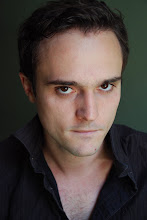Plot: A British World War I pilot gets off course and lands on an American Air Force base - in 1959. After battling guilt for his cowardice, he summons the courage to return to his time to rescue the comrade he abandoned.

I'm slowly starting to see what makes for a good Twilight Zone episode. The first necessity is, of course, something undeniably weird. Last week's "The Fever" had weird in spades, so how did it fall so low? To give the right impression, the episode needs to establish its weirdness early on; it sets the framework for what's to come. "The Fever" had the tone of a public service announcement, with the real weirdness -- the walking slot machine that I promise not to mention again -- only coming into play in the last few minutes. In this episode, the pilot's anachronistic voyage is the first event, and its ramifications reverberate throughout the story world. The second necessity in a good Twilight Zone episode, a moral or highlighted virtue, fills out Act II here. The pilot considers himself a coward and tries to find the courage to go back into battle. Book ending the tale is a return to the initial weirdness as the pilot files off into the unknown and the episode draws to a logical (insomuch as time travel is logical) conclusion.

This is an enjoyable episode.
... and as such I find it necessary to point out that it's another non-Serling script. This is beginning to become something of a trend. It really makes me want to marathon all of the Matheson and Beaumont episodes, but in keeping with the once-a-week, "relive the original airing schedule" nature of this blog, I'll resist the urge.
On the topic of trends, writer Richard Matheson, at this point in his career, seems hung-up on flying vehicles. The Serling-penned scripts for "And When the Sky was Opened" and "Third From the Sun" both revolved around spaceships, and were both adapted from Matheson stories. Future classic Matheson Twilight Zones (that we'll get to someday) include "The Invaders" and "Nightmare at 20,000 Feet," about a spaceship and an airplane, respectively. We've already discussed the fascination with space travel in this era of American history, but why so much emphasis on airplanes?
The era of commercial air travel was still in its infancy in 1960, and as with any new technology, there was a strong public interest. Add to that interest a hint of the paranormal, and you've got yourself a highly marketable combination for science fiction / fantasy, not unlike the cyberpunk trend in literature of the 90's. Like the insecurities surrounding space travel that we discussed after "And When the Sky was Opened," the viewing public had reason to be wary of air travel. Amelia Earhart went missing in 1937 during an attempt to circle the globe in a plane. To this day no remains of either her person or her plane have been found. The 50's had marked the first published observations of the disappearance of aircraft in the Bermuda Triangle, a phenomenon from which the idea for this episode probably sprang.

For more on the Bermuda Triangle, check out episode 5 of The Paranormal Podcast. In it, the host interviews a man who flew through the Bermuda Triangle and lived to tell about it. What he saw, and the sincerity with which he speaks, might surprise you. Some of you are undoubtedly rolling your eyes, but any good fantasy has its foundation in reality, and the story he tells could make you wonder at the validity of the other weirdness that we see each week...
... in the Twilight Zone.

No comments:
Post a Comment